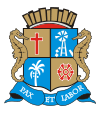Aracaju
| Aracaju | |||
| — Municipality — | |||
| The Municipality of Aracaju | |||
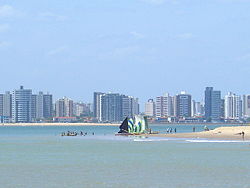 |
|||
|
|||
| Nickname(s): "Cajueiro dos Papagaios" ("Cashew tree of the Parrots") | |||
| Motto: "Cidade de Todos" ("City of Everybody") | |||
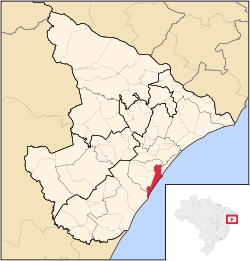 |
|||
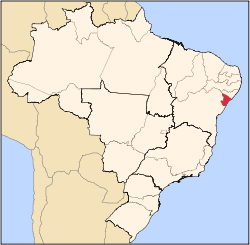 |
|||
| Country | |||
|---|---|---|---|
| Region | Northeast | ||
| State | |||
| Founded | 1592 | ||
| Incorporated (as capital) | march 17, 1855 | ||
| Government | |||
| - Mayor | Edvaldo Nogueira (PC do B) | ||
| Elevation | 4.0 m (13 ft) | ||
| Population (2006) | |||
| - Total | 505,286 | ||
| - Density | 2,903.9/km² (7,521.1/sq mi) | ||
| Time zone | UTC-3 (UTC-3) | ||
| - Summer (DST) | UTC-2 (UTC-2) | ||
| HDI (2000) | 0.794 – medium | ||
| Website: Aracaju, Sergipe | |||
Aracaju is the capital of the State of Sergipe, Brazil. It is located in the northeastern part of the country, about 350 km (217 mi) north of Salvador. It has a population around 505,286 inhabitants, which represents approximately 33% of the state population. The coast of Aracaju has many unspoiled beaches, such as the ones in Santa Luzia Island, and urban beaches, such as the Atalaia. These coastal neighborhoods include playgrounds, squares, open-to-the-public football, volleyball, and basketball fields, residential buildings, bars, nightclubs, restaurants, banks and hotels.
Aracaju, one of the first cities to be planned in Brazil, was established there and built with the intention of becoming the state capital. Founded in 1855, the capital of Sergipe.
The new Aracaju International Airport connects Aracaju with many Brazilian cities and also operates some international flights from Montevideo, Uruguay.
The city is home to the Federal University of Sergipe.
Contents |
History
Although the Portuguese founded a colony here in 1592, the capital of the infant state of Sergipe was moved to nearby São Cristóvão (Saint Christopher). Then, in the mid-nineteenth century, there was a sudden vogue for purpose-built administrative centres (similar to the urge that led to the construction of Brasilia a century later), and the core of modern Aracaju was thrown up overnight, becoming the state capital again in 1855. In 1910, the city was made the seat of the Roman Catholic Archdiocese of Aracaju.
Unlike the other Brazilian state capitals planned and built in the nineteenth century, Aracaju is known throughout the country for its modern looks, some festivals and carnival, and is known to have some good beaches, among other attractions. Though most tourists rush to Rio to visit its celebrated beaches, a local secret and national treasure is the Northeast and among the many jewels lies Aracaju. Oil wealth, sugar cane, and tourism continues to stimulate its growing economy, renovations, and continues to allow the city to shine in its splendor as the capital of Sergipe. Colonial towns of Laranjeiras and São Cristóvão are only a short bus ride away (Adapted from The Rough Guide to Brazil (2000), UK).
Geography
Climate
| for Aracaju | |||||||||||||||||||||||||||||||||||||||||||||||
|---|---|---|---|---|---|---|---|---|---|---|---|---|---|---|---|---|---|---|---|---|---|---|---|---|---|---|---|---|---|---|---|---|---|---|---|---|---|---|---|---|---|---|---|---|---|---|---|
| J | F | M | A | M | J | J | A | S | O | N | D | ||||||||||||||||||||||||||||||||||||
|
39
30
24
|
44
30
24
|
53
30
24
|
119
30
24
|
151
29
23
|
153
28
22
|
120
27
22
|
81
27
22
|
50
28
23
|
39
28
23
|
36
29
24
|
29
29
24
|
||||||||||||||||||||||||||||||||||||
| temperatures in °C precipitation totals in mm source: MSN Weather |
|||||||||||||||||||||||||||||||||||||||||||||||
|
Imperial conversion
|
|||||||||||||||||||||||||||||||||||||||||||||||
Aracaju have a typical tropical climate, with warm to hot temperatures and high relative humidity all throughout the year. However, these conditions are relieved by a near absence of extreme temperatures and pleasant trade winds blowing from the ocean. January is the warmest month, with mean maxima of 32°C (89.6°F) and minima of 22°C (71.6°F) and more sun; July experiences the coolest temperatures, with mean maxima of 27°C (80.6°F) and minima of 17°C (62.6°F) and more rain.
Vegetation
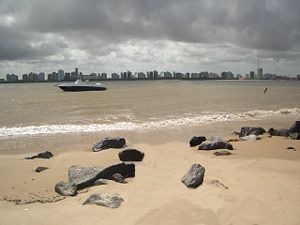
Aracaju has a Tropical forest. Rainforests are characterized by high rainfall, with minimum normal annual rainfall between 2,000 mm (about 78 inches or 2 meters) and 1700 mm (about 67 inches). The soil can be poor because high rainfall tends to leach out soluble nutrients. There are several common characteristics of tropical rainforest trees. Tropical rainforest species frequently possess one or more attributes not commonly seen in trees of higher latitudes or trees in drier conditions on the same latitude.
Economy
The economy is based on services, industry and tourism.
The GDP for the city was R$ 5,021,660,000 (2005).[1]
Education

Portuguese is the official national language, and thus the primary language taught in schools. But English and Spanish are part of the official high school curriculum.
Educational institutions
- Universidade Federal de Sergipe (UFS) (Federal University of Sergipe);
- Universidade Tiradentes (Unit) (Tiradentes University);
- Faculdade São Luís (FSL) (São Luís College);
- Sociedade de Ensino Superior de Sergipe;
- and many others.
Culture


Museum
Museu do Artesanato, Museu do Instituto Histórico e Geográfico de Sergipe, Museu do Homem Sergipano, Museu Memorial de Sergipe, Museu de Antropologia, Museu de Arte Bélica da Polícia Militar de Sergipe and Museu de Arte e História Rosa Faria.
Library
Arquivo Público Estadual de Sergipe, Biblioteca da FANESE and Biblioteca Pública Epiphâneo Dórea.
Movies
Movie theaters in the Jardins Mall (CINEMARK).
Infrastructure

International Airport
The city is served by the Aracaju International Airport. It started operating on the 30th of October 1952 with a single 1200m runway. The airport did not have an access road until 1958. In 1961, the runway was extended to 1500m and a terminal of passengers was built in 1962. In February 1975 the airport administration was undertook by Infraero.
Highways
Aracaju is connected to the main cities of Brazil by BR-235 and BR-101 federal highways.
Sister cities
References
- ↑ (in Portuguese) (PDF)GDP. Aracaju, Brazil: IBGE. 2005. ISBN 85-240-3919-1. http://www.ibge.gov.br/home/estatistica/economia/pibmunicipios/2005/tab01.pdf. Retrieved on 2007-07-18.
External links
- Aracaju is at coordinates
|
||||||||||||||||||||||||||
|
|||||||||||||||||||||||||||||
|
||||||||||||||||||||
|
|||||

